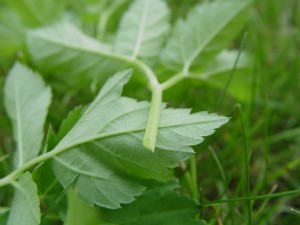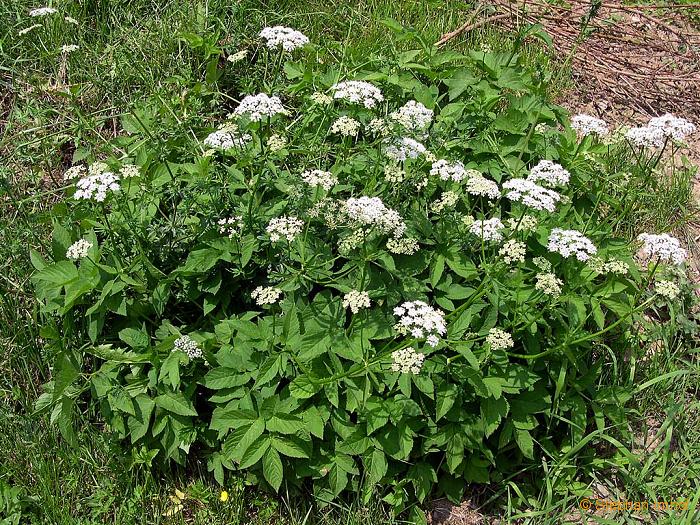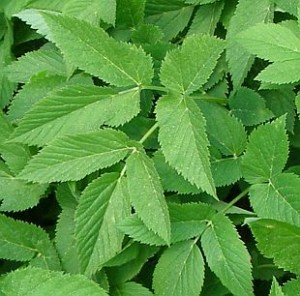Gout Weed does not sound too appetizing. Nor do some of its other names: Ground Ash, Ashweed, Pot Ash, White Ash, Ground Elder, Dog Elder, Dwarf Elder, Garden Plague, Farmer’s Plague, Snow-on-the-Mountain, Jack Jumpabout, Jump About, Goat’s Foot, Bull Wort, Bishop Wort, Bishop Weed, Herb William and Herb Gerard…
Herb Gerard? I happen to know this one: Saint Gerard, 1726-1755. His gout was reportedly cured by the plant but it was tuberculosis that got him at age 29. He’s the patron saint of expectant mothers. Gerard was a man of the cloth for only three years but managed to make a name for himself. He was nominated in 1893 for sainthood for a miracle that helped a pregnant woman. He became a saint in 1904. Another attribute was he named the day and hour of his death. What I would like to know is how he managed to get gout as such an early age?
Gout Weed has a long history of medicinal use besides being cultivated for food. It was the main gout treatment. One theory is the clergy got a lot of gout because they ate better than most but reports about St. Gerard say he lived poorly, giving half of what he ever made to his mother and the other half to those more poor than he. All parts of the plant are diuretic. It has been used to also treat rheumatism, arthritis and bladder disorders. Some credit consumption of the plant, others external use in the area of the gout, such as crushing the root and holding it at the joint.
While it may have indeed been medicinal it was also a prime salad ingredient and pot herb in Europe. It is now naturalized in many areas of North America including most of Canada, the eastern United States excluding most of the Old South and West save for Oregon, Washington, Idaho and Montana.

Note the veins of Gout Weed leaf terminate at the tip of a tooth. In the toxic hemlocks the veins terminated between the teeth.
The young leaves of the Gout Weed are translucent and shiny green. Tender and aromatic, they are excellent additions to salads as are young stems. When older they are often cooked with cheese. They have been added to fritters as well. In northwest Germany Gout Weed is made into grune suppe, green soup. As for taste, opinions are divided. You either love it or hate it. As a vegetable it is very prolific and spreads by rhizomes.
Botanically Gout weed, or Goutweed, is Aegopodium podagraria, ee-guh-POH-dee-um pod-uh-GRAR-ee-uh, or, ee-go-poh-DEE-um pod-uh-GRAR-ee-uh. The genus, Aegopodium, is from the Greek words “agios” meaning goat and “podion” which means little foot. Little Goat Foot, so named because the shape of the leaf resembles the shape of a goat’s foot. Podagaria is also Greek and means “gout of the foot.”
DO NOT CONFUSE THIS PLANT WITH THE DEADLY TOXIC WATER HEMLOCK.
Green Deane’s “Itemized Plant Profile: Gout Weed
IDENTIFICATION: Small, white, five-petaled flowers mid-summer, arranged in flat-topped clusters a leafy stem up to three feet tall. Seeds small, elongate, similar to carrot seeds, ripen in late summer. Rhizomes — NOT EDIBLE — are long, white, and branching. Leaf veins terminate at the tips of teeth.
TIME OF YEAR: Late spring to early fall.
ENVIRONMENT: Gout Weed is very accommodating. It has no soil preference nor is soil acidity or lack there of a problem. It can grow in full shade to full sun but does requires moist soil. Makes a strong and invasive ground cover. Requires little maintenance.
METHOD OF PREPARATION: Leaves, raw or cooked, tangy, reminds one of incense. Like many plants the leaves are best harvested before the plant blossoms. They can be added raw to salads, cooked in fritters, added to soups or used as a potherb.




